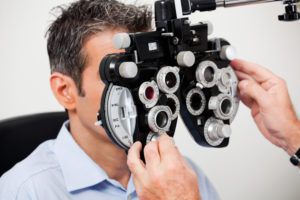| Prescriptions are written differently depending on whether it was from an Optometrist or an Opthamologist. |
An Optometrist O.D. is a health care professional who is licensed to prescribe glasses, contact lenses and provide low vision rehabilitation. Examine and diagnose common eye diseases and to inspect, diagnose and treat visual conditions.
|
An Ophthalmologist M.D. is a medical doctor who is trained to provide complex and delicate eye surgery. They examine, diagnose and treat eye diseases such as glaucoma, cataracts, and retinal diseases. They may also be involved in eye research.
|
|
Optometrist vs. Ophthalmologist |
| An Optometrists prescription is written in minus (-) cylinder and an Ophthalmologists prescription is written in plus (+) cylinder. The following prescriptions have the same result but look different because of the way they were written. |
Optometrists Prescription
Cylinder power has a minus (-) sign
| Sphere | Cylinder | Axis |
| R | -2.25 | -0.75 | 125 |
| L | -2.00 | -1.25 | 085 |
|
Ophthalmologists Prescription
Cylinder power has a plus (+) sign
| Sphere | Cylinder | Axis |
| R | -3.00 | +0.75 | 035 |
| L | -3.25 | +1.25 | 175 |
|
| |
|
More examples of how prescriptions can be written |
A plus (+) or minus (-) sign should be included in front of all numbered sphere and cylinder values.
|
Minus Sphere Only Prescription
No cylinder or astigmatism correction
SPH stands for sphere only, no cylinder.
Sphere only prescriptions have no Axis value.
| Sphere | Cylinder | Axis |
| R | -2.25 | SPH | |
| L | -2.00 | SPH | |
|
Plus Sphere Only Prescription
No cylinder or astigmatism correction
DS stands for diopter sphere only, no cylinder.
Sphere only prescriptions have no Axis value.
| Sphere | Cylinder | Axis |
| R | +2.25 | DS | |
| L | +2.00 | DS | |
|
| |
Minus on Minus Prescription
Sphere and Cylinder are both minus (-)
| Sphere | Cylinder | Axis |
| R | -2.00 | -0.75 | 107 |
| L | -2.00 | -1.25 | 085 |
|
Plus on Minus Prescription
Sphere plus (+) and Cylinder minus (-)
| Sphere | Cylinder | Axis |
| R | +2.00 | -0.75 | 107 |
| L | +2.00 | -1.25 | 085 |
|
| |
Minus on Plus Prescription
Sphere minus (-) and Cylinder plus (+)
| Sphere | Cylinder | Axis |
| R | -2.00 | +0.75 | 107 |
| L | -2.00 | +1.25 | 085 |
|
Plano Sphere with Cylinder Prescription
Sphere Plano (0) and Cylinder minus (-)
| Sphere | Cylinder | Axis |
| R | PL | -0.75 | 107 |
| L | +0.50 | -1.25 | 085 |
|


